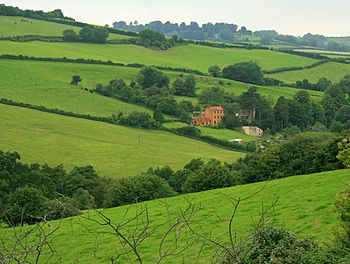Lam Brook facts for kids
Quick facts for kids Lam Brook |
|
|---|---|

Mill Farm on the upper reaches of the Lam Brook
|
|
| Other name(s) | Lambroc - Anglo-Saxon |
| Country | England |
| Region | West of England |
| Municipality | Bath |
| Physical characteristics | |
| Main source | Lansdown, Bath, South Gloucestershire, England 656 ft (200 m) 51°25′03″N 2°23′33″W / 51.4175°N 2.3926°W |
| 3rd source | St Johns Wood Toghill, South Gloucestershire, England 580 ft (180 m) 51°26′48″N 2°23′18″W / 51.4467°N 2.3883°W |
| River mouth | Bristol Avon Lambridge, Bath, England 60 ft (18 m) 51°23′44″N 2°20′21″W / 51.3955°N 2.3393°W |
| Length | 2.5 mi (4.0 km), southerly |
| Basin features | |
| River system | Bristol Avon |
The Lam Brook is a small river, also called a stream, in the west of England. It starts from several springs in the southern part of the Cotswold Hills. The brook flows south for about 2.5 miles (4.0 km) (that's about 4 kilometers). It then joins the larger River Avon in a place called Lambridge, near the city of Bath. People have known about the Lam Brook for a very long time. It's even mentioned in an old document from the Anglo-Saxon period, though we don't know the exact date of that document. In the past, there were watermills along the brook. These mills used the power of the flowing water. Today, none of these old mills are still working. The water in the Lam Brook is quite clean. Many different animals live here, including a special type of crayfish called the white-clawed crayfish.
Where the Lam Brook Flows
The Lam Brook starts from many small springs. These springs are found in the southern part of the Cotswold Hills. Some of the main starting points are at Lansdown, Toghill, and Cold Ashton. These places are in South Gloucestershire.
All these small streams come together near Ashcombe Farm. This farm is close to a village called Langridge. From there, the Lam Brook flows mostly south. It passes by Ashcombe House. It also flows through the villages of Upper Swainswick and Lower Swainswick.
When the Lam Brook reaches Lambridge, another small stream joins it. This stream flows into the Lam Brook from its right side. Right after this, the Lam Brook flows into the Bristol Avon.
History of the Lam Brook Area
People believe that an ancient Roman road once crossed the Lam Brook. This road was called the Fosse Way. It probably crossed the brook near where Lambridge is today.
The Lam Brook is mentioned in a very old document. This document is an Anglo-Saxon charter. It describes the boundaries of the village of Charlcombe. The Lam Brook was part of these boundaries. We don't know the exact year this document was written.
Like many rivers in the area, the Lam Brook had watermills built along it. These mills were especially common in the Swainswick valley and at Lambridge. One old mill, Mill Farm at Woolley, still stands. However, it has been changed and is now used for other things. An old paper from 1275 talks about "two fulling mills" at Lambrugge. Fulling mills were used to clean and thicken cloth. A map from 1729 also shows a place called "Dead Mill" a bit further upstream.
Amazing Animals of the Lam Brook
The Lam Brook is home to some interesting wildlife. You can find salmon and white-clawed crayfish in its waters. The white-clawed crayfish is a special type of crayfish. It is quite rare in many places.
Every year, a road in Charlcombe is closed for about seven weeks. This happens in February and March. The road closure helps newts, frogs, and toads. It allows them to safely cross the road. They are traveling to a lake in the Charlcombe valley. This lake is on a small stream that flows into the Lam Brook.
A volunteer named Helen Hobbs helps these amphibians. She received an award in 2010 for her amazing work. She helped save around 4,500 newts, frogs, and toads!

